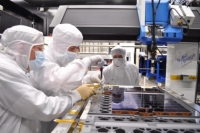BRC developed a conceptual plan and schematic design that provided the framework for Liverpool’s first story-driven and object-rich museum, offering a panoramic perspective of Liverpool’s great social history
BRC Imagination Arts, one of the world’s leading experience designers and creators of distinctive exhibits and attractions for museums, science centres and cultural heritage venues, is the Exhibition Master Planner for the new National Museum of Liverpool, which opens its doors on July 19. In partnership with the architect and the Museum of Liverpool content team, BRC helped to create a story-led, object-rich, interactive, highly flexible environment that immerses visitors in the wonders of Liverpool’s past, present and future, ultimately engaging them with interpretive experiences based on stories of Liverpool’s history and achievements.
A story-driven, people-centric approach
As exhibition master planner, BRC was responsible for developing the museum’s conceptual plan and schematic design, and worked closely with the Museum of Liverpool content team to write the brief for every exhibit, including each exhibit’s theme, story line and the specific collections of art and artefacts the exhibits would display. Each brief was developed to reinforce the Museum of Liverpool’s over-arching theme, “Liverpool, a Wondrous Place.” BRC took a holistic approach, where every element of the museum – presentations, programmes, visitor flow, operations – contribute to provide a meaningful, memorable visitor experience.
In partnership with the museum’s content team and numerous curators from many of the seven museums operated by the National Museums Liverpool, BRC created a framework for the museum that is completely story-led and object-driven. Every display revolves around compelling, emotional stories told by actual citizens of Liverpool, past and present, giving the museum a uniquely human and dynamic voice. Each object in the museum was selected to support these stories and reinforce the theme that Liverpool is a “Wondrous Place.” For example, visitors can see the stage on which Paul McCartney and John Lennon first met as they’re immersed in the story of how the Beatles came to be.
“As we worked on the exhibition planning, the team unanimously agreed they needed to be told through the lens of Liverpool’s people,” said Christian Lachel, vice president of BRC and creative director during the master planning phase. “Working with the Museum of Liverpool team, we interviewed citizens involved in actual events in Liverpool, including citizens now living elsewhere, such as noted author Clive Barker, who BRC met with in Los Angeles. Each person shared their experiences and perspectives on the city, which we used to fit into our master plan, taking the spirit of their stories and embedding them into the exhibitions. The museum offers a dynamic social history of Liverpool that is literally of the people, by the people and for the people.”
The museum curators BRC worked with come from diverse fields, including transportation, geology, music, history, art and archaeology. Every curator had a voice, and BRC created a forum where they could share ideas and tell their story, whether it was about Liverpool’s great history as a port city, the story of the city’s iconic overhead railway or the thriving artistic and literary community that make Liverpool an intellectual hub of Europe.
Flexibility and accessibility
As schematic designer, BRC worked closely with the architect, engineers and Museum of Liverpool senior leadership to create an environment that was totally flexible, so the objects and exhibitions could be changed out frequently, allowing more stories to be told over time. Creating this infrastructure was like building a giant ship, with many different components that needed to fit together – entryways, a flexible power and data grid, the modular exhibition system, resting areas for visitors, the seating and display systems, and the positions for the various galleries. BRC worked with the engineers and architects to integrate these features into the museum planning to ensure a seamless visitor experience that could be easily expanded and changed.
“BRC believes museums of the future cannot be static,” Lachel said. “They must be dynamic, with fresh content and new stories. In creating the framework we took the stories into account as well as the need to constantly update and build upon them. Within that framework, our goal was to keep visitors engaged and comfortable as they move from one exhibit to the next.”
Accessibility is another key feature of the museum. As a team, BRC and the Museum of Liverpool leadership and staff strived to achieve best practices in accessibility, accommodating the special needs of visitors with disabilities or restricted movement. Admission to the museum is free, breaking down barriers and opening its doors to all the diverse communities of Liverpool from every social stratum.
The galleries and collections
Along with the oral testimonies, the Liverpool story is told through archaeological material, social and urban history objects, entomology collections, botanic collections, photographic archives, costume and decorative art collections. Content is structured into four core themes: the Great Port, Global City, People’s Republic and Wondrous Place, located in four large gallery spaces. Touch screens, video and other multimedia effects make the experience highly interactive. Another highlight of the museum is “History Detectives,” an interactive resource centre that gives visitors an opportunity to touch and feel various objects from the collection and learn where they came from, who owned them, and what their story and social history is.
Each gallery of the 4800-square-meter museum is people-driven, object-rich and immersive. For example, the People’s Republic gallery gives the impression that the visitor is stepping into the city – it’s busy and densely populated with stories of people, which can be heard, read, seen and experienced. For the flexible exhibition system master plan, BRC imagined a series of modular cases, which can be joined together and reconfigured, as well as a series of walls and units that can have their contents changed quickly and easily.
The museum possesses more than three million objects and works of art. One of BRC’s greatest challenges was determining how to do justice to so much excellent content. The final master plan design, worked out in close collaboration between BRC, the architects, the curators and the content and design teams, provides the flexibility to continually show more objects and tell more stories, while seamlessly combining techniques from traditional museum design with media, theater, technology and immersive special effects to showcase Liverpool’s wondrous stories of history, culture and science.
“Most people are unaware of Liverpool’s extraordinary history as a major port city and home to some of the most talented writers, scientists, musicians and artists,” Lachel said. “There is so much more to Liverpool than the Beatles and football, important as they are to the city’s history. Liverpool boasts a rich cultural past, a dynamic present and a promising future. BRC is proud to work with National Museums Liverpool to create one of the world’s most people-driven, experiential museums, a gateway to the wondrous city of Liverpool and a treasure trove of art and objects, all presented with the amazing stories behind them.”
About BRC Imagination Arts
BRC Imagination Arts is comprised of an energetic and experienced group of creative thinkers, designers, artists, media producers, writers, project managers and technologists who spend their days breathing the intricacies involved in everything it takes to create world-class museums and cultural attractions.
Today’s 21st century audience is increasingly drawn toward immersive experiences over traditional static exhibits. In the forefront of this sea change, BRC Imagination Arts is re-inventing museum exhibition design for today’s audience. The key to this reinvention lies in unlocking the authentic and dramatic stories inherent in a collection or place, and taking the next step of transforming those artifacts and stories into memorable and lasting museum and cultural experiences.
BRC’s distinct approach to museum exhibit design allows museum curators to tell great stories of history, culture and science, all presented by seamlessly combining techniques from traditional museum design with media, theater, technology and immersive storytelling.
BRC clients include the Abraham Lincoln Presidential Library and Museum, The Great Wall World Heritage Museum, Colorful Guizhou Cultural Tourism, Taronga Zoo, The Texas State History Museum, The Henry Ford Museum, Adler Planetarium and Astronomy Museum, Louisiana’s Old State Capitol, National Health Museum, National Museums Liverpool, Arizona Science Center, NASA’s Kennedy Space Center Visitor Complex and many more.















